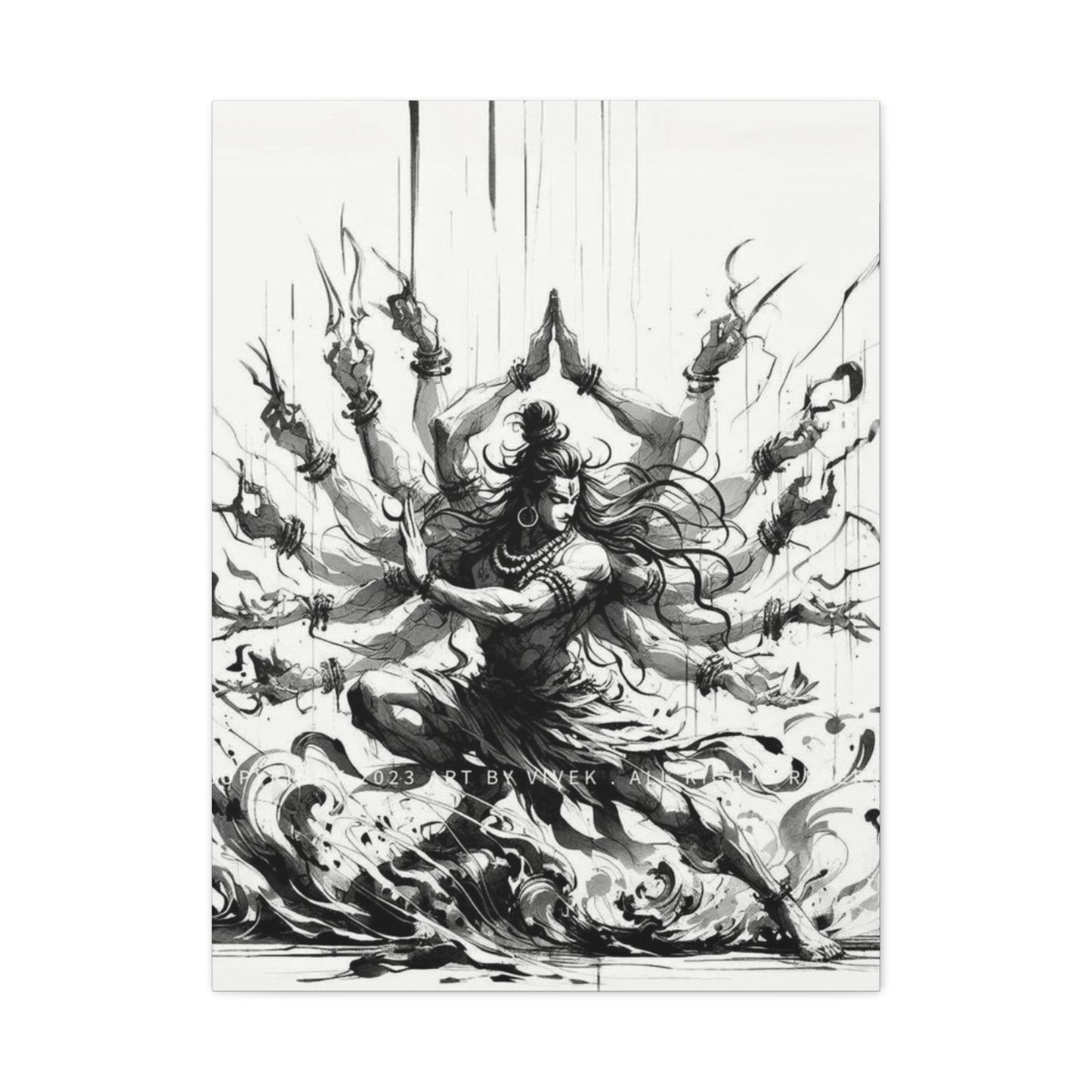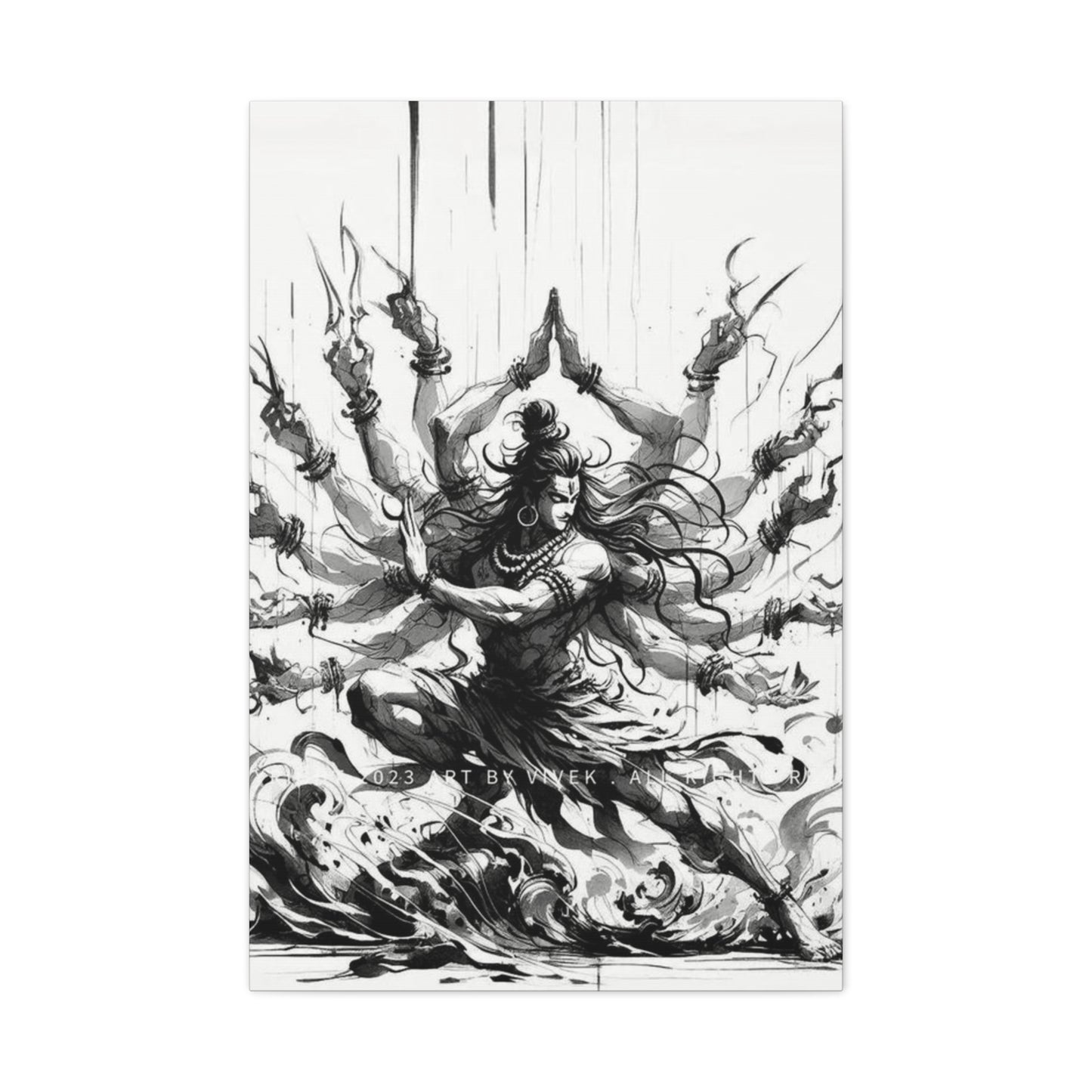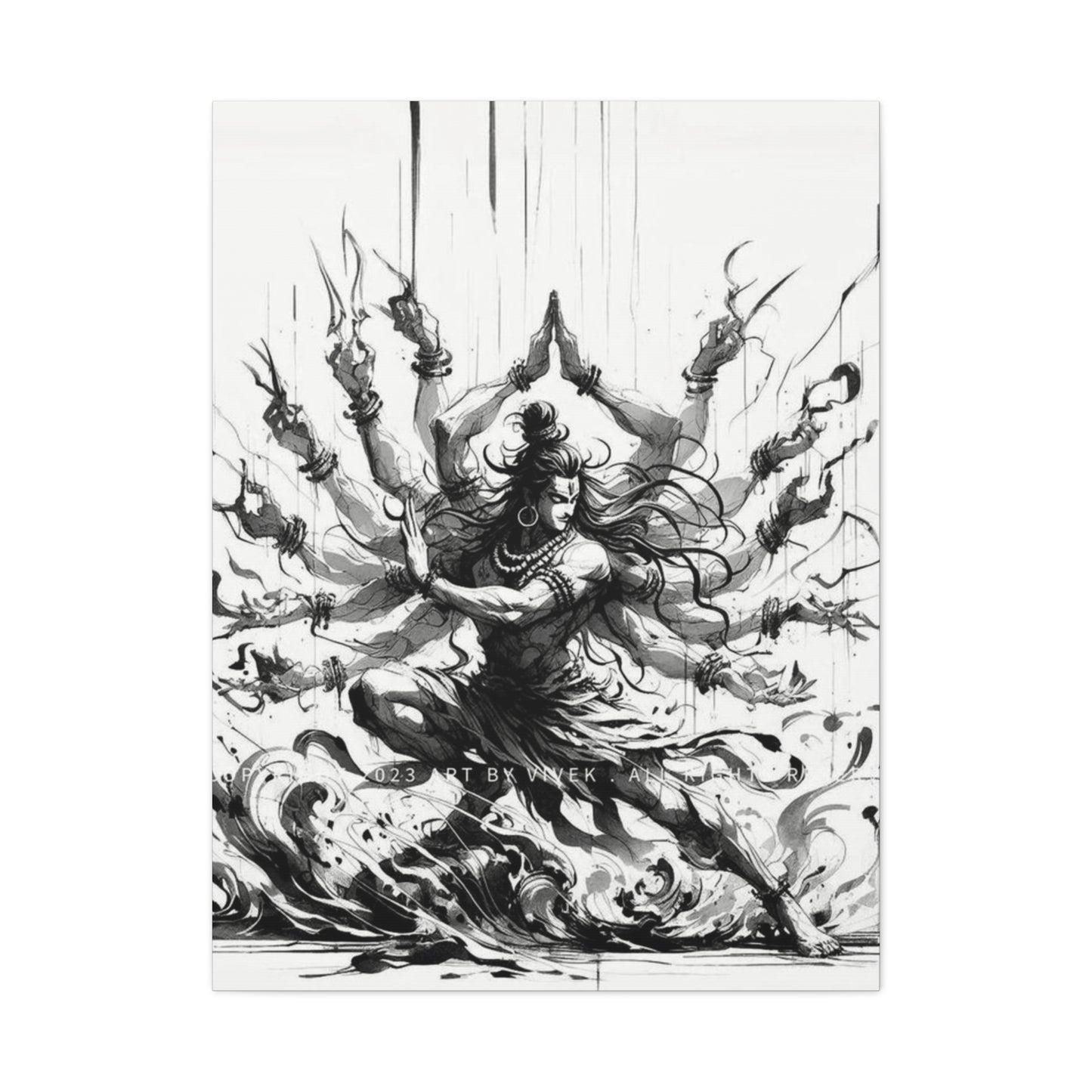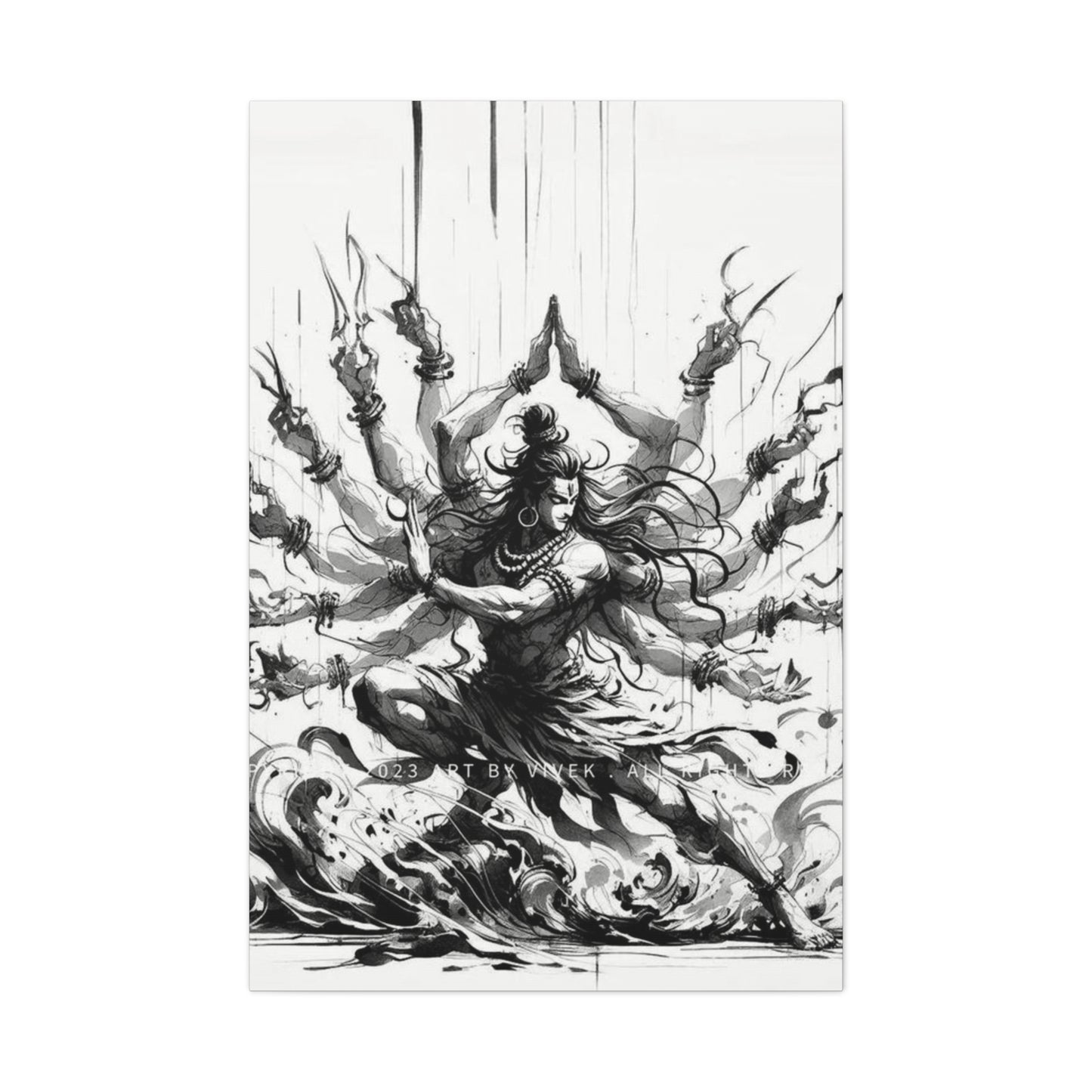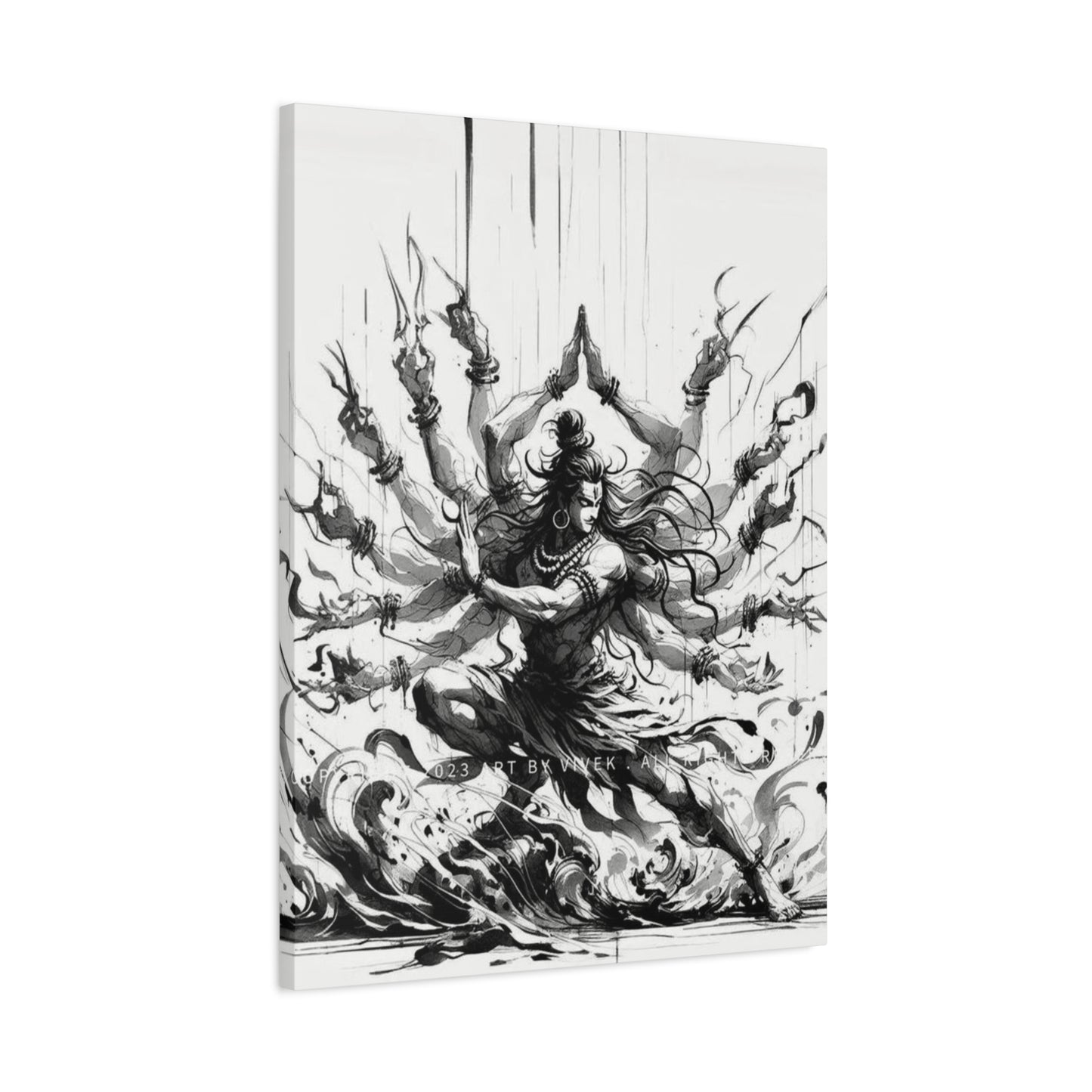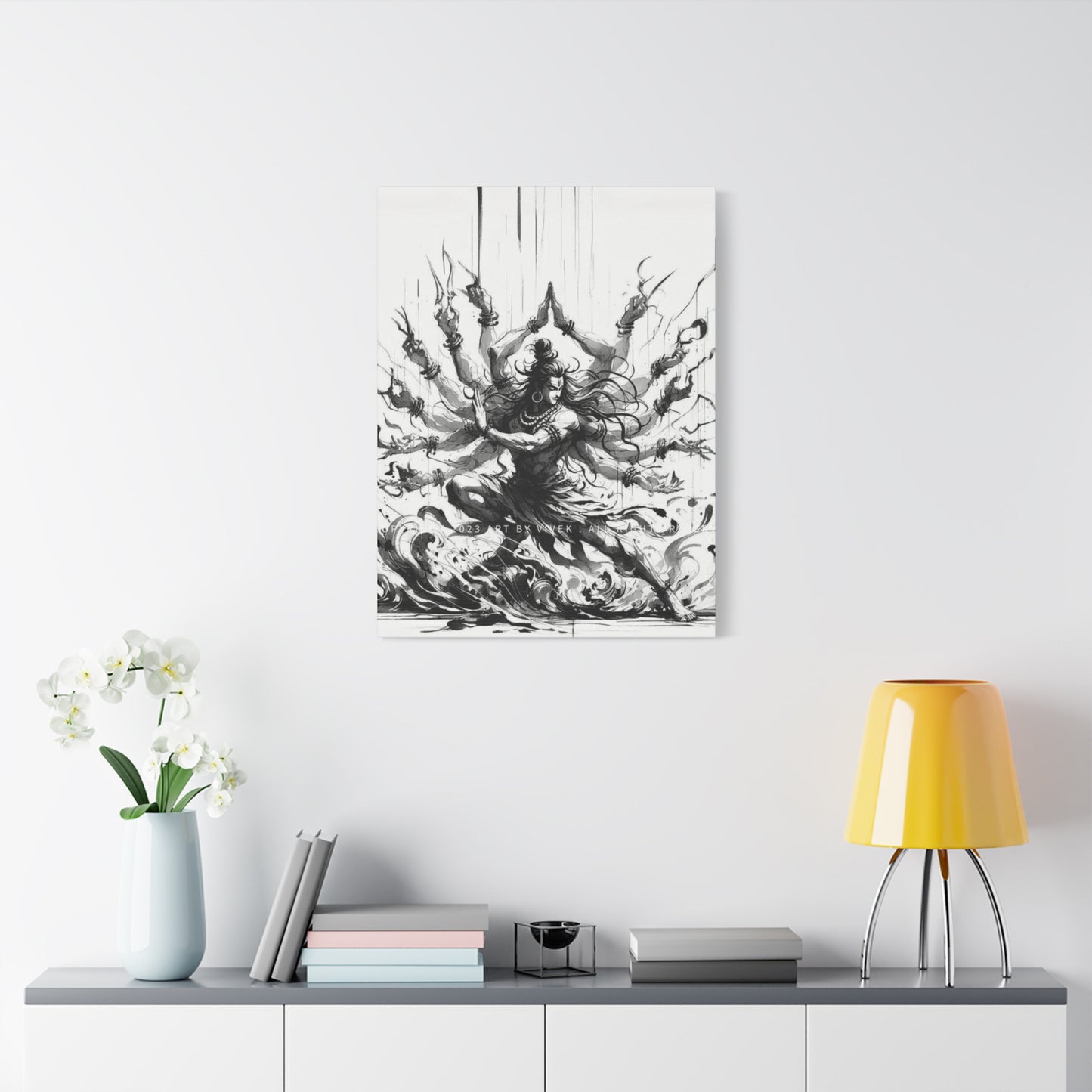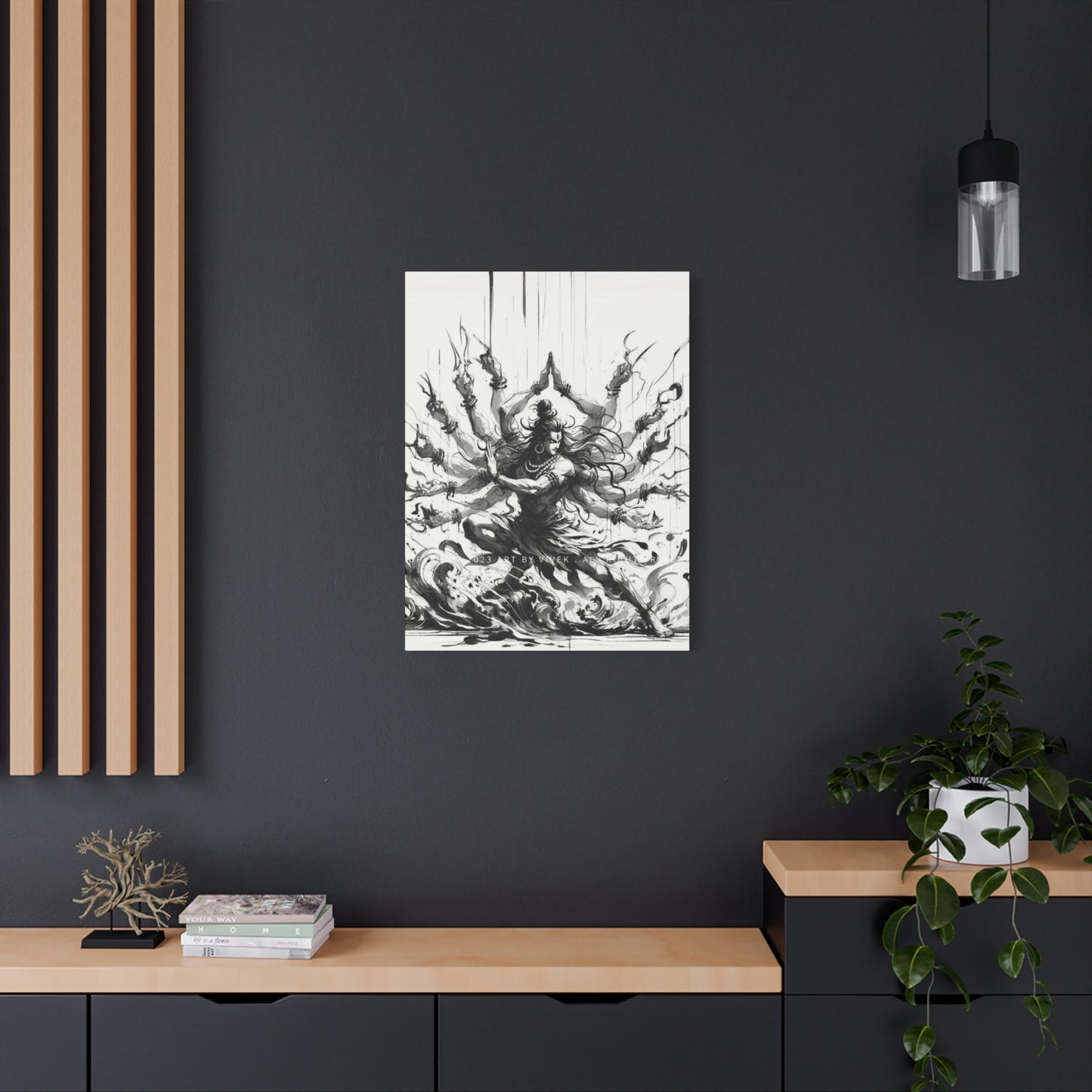Echoes of the Cosmic Dance: Adorning Your Space with Shiv Tandav Wall Art
The universe is in a constant state of flux, a perpetual dance of creation, preservation, and dissolution. This cosmic rhythm, the very heartbeat of existence, finds its most profound and powerful artistic expression in the depiction of the Shiv Tandav. The Tandava, or the cosmic dance of Lord Shiva, is a symbol of immense power, boundless energy, and the cyclical nature of life itself. It is a concept that has captivated philosophers, poets, spiritual seekers, and artists for millennia. To bring a representation of the Shiv Tandav into one's home is to do more than simply decorate a wall; it is an invitation for this primordial energy to inhabit your space, to infuse it with a sense of purpose, strength, and divine awe. Shiv Tandav wall art is not merely an object of aesthetic appreciation.
It is a conduit, a focal point for meditation, a statement of fearless interior design, and a constant reminder of the universe's dynamic and unceasing motion. Whether rendered in the fiery hues of a canvas painting, the sharp, definitive lines of metalwork, or the subtle grace of a silhouette, this sacred art form has the unique ability to transform a room from a simple living area into a sanctuary of power and contemplation. It speaks a universal language of rhythm and force, resonating with anyone who seeks to connect with the deeper currents of existence. This exploration delves into the multifaceted world of Shiv Tandav wall art, examining its spiritual significance, its impact on interior aesthetics, and the myriad ways in which artists capture this celestial dance, allowing you to find the perfect expression of cosmic energy for your personal domain.
Channeling Cosmic Power: The Essence of Shiv Tandav on Your Walls
To place an image of the Shiv Tandav on a wall is to hang a piece of the cosmos itself within your home. The essence of this art form lies in its ability to channel and represent the unbridled cosmic power that governs all of existence. This is not static imagery; it is a depiction of the universe at its most dynamic. The Tandav is a dance of profound dualities. In its gentler form, the Ananda Tandava, it is the dance of creation, performed in an aura of bliss, bringing forth the worlds and setting the celestial bodies in motion. In its fierce form, the Rudra Tandava, it is the dance of destruction, a cataclysmic rhythm that dissolves the universe back into a state of formless potential, thereby paving the way for a new cycle of creation. Shiv Tandav wall art captures this very cycle. The energy it exudes is that of the supreme, unmanifest reality becoming manifest. When you gaze upon a piece of Tandav art, you are witnessing the visual representation of the primordial sound, the 'Om' or 'Aum', from which all creation springs.
The locks of Shiva's hair fly outwards, symbolizing the expansion of the cosmos. The drum he holds, the damaru, represents the very rhythm of creation, its beats setting the tempo for life itself. The flame in his other hand signifies the power of transformation and destruction, the fire that purifies and consumes all in the end. His raised foot offers liberation and moksha, while the foot that presses down crushes the demon of ignorance, Apasmara. Every element in Shiv Tandav wall art is saturated with meaning and power. Choosing to display this art is a conscious decision to align your personal space with these fundamental cosmic principles. It becomes a daily reminder that change is the only constant, that every ending is a new beginning, and that within destruction lies the seed of creation. The art radiates a powerful vibration, a frequency that can alter the energy of a room.
Infusing Your Ambiance with the Tandav's Cosmic Beat
Every space has a rhythm, an underlying beat that defines its character and influences the mood of its inhabitants. Some rooms are calm and meditative, others are vibrant and social. Infusing your ambiance with the Tandav's cosmic beat means introducing a powerful, primordial rhythm into your environment, transforming it into a space that resonates with energy, purpose, and a sense of the infinite. Shiv Tandav wall art is the most direct way to achieve this. The visual rhythm of the artwork—the flowing lines, the dynamic posture, the radiating energy—translates into a palpable atmospheric frequency. The presence of the Nataraja is not silent; it metaphorically echoes the sound of the damaru, the drum whose vibrations are said to have created the world. This silent sound, this visual beat, can enliven a stagnant space and bring a new level of vitality. To truly bring the Tandav's rhythm to your space, consider the artwork's placement and the sensory experience of the room as a whole.
The artwork should be placed where it can become a focal point, a center of energy from which the room's rhythm can emanate. A large wall in a living room, a commanding position in an entryway, or a place of honor in a creative studio are all ideal locations. The goal is to allow the artwork's energy to flow, uninterrupted, into the space. You can amplify this rhythmic effect by incorporating other elements that resonate with the theme. The use of sound, for instance, can be a powerful tool. Playing ambient music with subtle drum beats, classical Indian ragas, or even recordings of sacred chants in the room can create an auditory layer that complements the visual rhythm of the Tandav art. The combination of sight and sound can create a deeply immersive and meditative atmosphere. The rhythm can also be expressed through texture and pattern. Think of repeating patterns in textiles, the grain of wood, or the weave of a rug as a form of visual rhythm.
A geometric patterned rug, for example, can represent order and structure, providing a grounding counterpoint to the wild, free-flowing energy of the Tandav. The interplay of different textures—the smoothness of metal, the roughness of stone, the softness of fabric—can create a tactile rhythm that adds depth and complexity to the room's ambiance. Light, too, can have a rhythm. The changing patterns of natural light throughout the day create a slow, steady pulse. You can introduce a more dynamic rhythm with adjustable lighting. Using dimmer switches or smart bulbs allows you to change the intensity and color of the light, altering the mood of the room to match different activities, from quiet contemplation to energetic social gatherings. By introducing the Tandav's rhythm, you are essentially setting a new tempo for your life within that space. It becomes a place that encourages dynamic action rather than passive rest. It is an environment that can spark creativity, foster courage, and inspire movement, both literally and metaphorically.
Shiva’s Cosmic Dance Manifested as Wall Decor
The transformation of a concept as profound and esoteric as Shiva's cosmic dance into a tangible piece of wall decor is a remarkable testament to the power of art. It is the process of taking an ancient philosophical and spiritual symbol and making it accessible, allowing its energy to be integrated into the fabric of our daily lives. When the Tandava manifests as wall decor, it ceases to be just an idea or a story in a sacred text; it becomes a physical presence, an object that radiates meaning and interacts with the space it occupies and the people who live there. This manifestation takes many forms, each offering a unique interpretation of the cosmic dance. A traditional Tanjore painting, for instance, presents the Nataraja in opulent splendor. With its rich colors, 22-karat gold leaf embellishments, and inlaid glass beads or semi-precious stones, this form of wall decor is a celebration of divine majesty. The artwork is not just seen; it is experienced.
The gold gleams and shimmers as the light changes, creating an illusion of movement and life, making the divine dancer seem to pulse with an inner luminescence. It’s a regal and reverent manifestation, perfect for spaces designed for worship or deep contemplation. In stark contrast, modern metal wall art offers a different manifestation. Here, the focus is often on form, line, and silhouette. Laser-cut steel, iron, or brass is used to create a crisp, minimalist outline of the Nataraja. This interpretation strips the image down to its essential dynamic form. The play of light and shadow becomes the primary artistic element. The solid metal form casts a dark, dancing shadow on the wall behind it, creating a compelling duality between substance and ephemera. This contemporary manifestation is ideal for modern, minimalist, or industrial interiors, proving that the ancient symbol can be powerfully relevant in a 21st-century context.
Canvas prints and paintings offer perhaps the most versatile medium for this manifestation. Artists are free to explore the Tandava through various styles, from hyper-realism to complete abstraction. An abstract painting might focus solely on the energy of the dance, using explosive splashes of color and bold, gestural brushstrokes to convey the cataclysmic power of the Rudra Tandava without a literal depiction of Shiva. A more photorealistic painting might meticulously detail every iconographic element, inviting close study and meditation on its symbolism. The choice of canvas art allows the homeowner to select a piece that resonates most deeply with their personal aesthetic and spiritual inclination. Even sculptural wall hangings, carved from wood or molded from resin, bring a three-dimensional vitality to the cosmic dance. These pieces have a tactile quality, a physical depth that makes the form of Nataraja project into the room. A hand-carved wooden panel brings warmth, tradition, and a connection to nature, while a polished resin sculpture might offer a sleek, modern finish.
Tandava in Motion: Wall Art That Inspires and Moves You
True art does more than just occupy space on a wall; it interacts with the viewer on an emotional, intellectual, and even spiritual level. Wall art depicting the Tandava, when successfully executed, is the epitome of this interactive experience. It is "Tandava in Motion" not because the artwork itself physically moves, but because it has the profound ability to move the viewer. It inspires action, evokes deep feeling, and can fundamentally shift the energy of both a person and a place. The inspirational power of this art form is immense. The image of Nataraja is one of supreme confidence, balance, and control amidst chaos. For an entrepreneur facing a challenging business environment, a student preparing for a difficult exam, or anyone navigating a period of uncertainty, this image can be a powerful source of motivation. It is a visual affirmation of the ability to maintain grace under pressure, to find a point of stillness within the whirlwind of life, and to master the forces around you rather than be consumed by them.
Shiva's dance is not erratic; it is a perfectly controlled and purposeful expression of power. Gazing upon it can instill a sense of focus and determination, encouraging the viewer to act with similar precision and purpose in their own life. The art moves you emotionally by tapping into a deep well of universal archetypes. The Tandava encompasses the entire spectrum of existence. It is fierce and terrifying, yet also blissful and graceful. It represents destruction, but also the promise of renewal. This complexity allows the artwork to resonate with a wide range of human emotions. On a day filled with frustration and anger, the fiery aspect of the Rudra Tandava can provide a safe and powerful outlet, a visual representation of that destructive energy being channeled and controlled. On a day of joy and creative breakthrough, the blissful Ananda Tandava can feel like a perfect reflection of that creative flow. The artwork becomes a mirror to the soul, validating and giving context to our own inner dance of emotions.
Furthermore, Tandav wall art can inspire physical movement. The very posture of the Nataraja is an invitation to embody its principles. For dancers, yoga practitioners, or martial artists, the artwork is a constant source of inspiration, a perfect representation of balance, strength, and fluidity. Placing such an art piece in a home gym, yoga studio, or rehearsal space can create an environment that encourages discipline and graceful expression. The image serves as a 'drishti,' a focal point for concentration, helping to align the body and mind. The motion is also intellectual. The intricate symbolism embedded in the art invites contemplation and study. It can spark a journey of discovery into Hindu philosophy, mythology, and cosmology. It moves the viewer from passive observation to active inquiry, encouraging them to learn about the meaning of the damaru, the Agni, the crescent moon, and the crushed demon Apasmara. This intellectual engagement deepens the connection to the artwork, transforming it from a mere decoration into a profound source of wisdom.
Invoking Power with Shiva’s Tandav
There are times when a space can feel lethargic, stagnant, or devoid of inspiration. In such moments, what is needed is not just a change of furniture or a new coat of paint, but a fundamental shift in the room's energy. Shiva's Tandav, in art form, serves as a powerful spiritual and psychological tool for this very purpose—it is a direct call to energy, a way to consciously invoke a sense of power, dynamism, and forward momentum into your environment. This process of invocation is rooted in the principle that our surroundings have a profound impact on our state of mind. By introducing a symbol of immense energy into our visual field, we can trigger a corresponding response in our own consciousness. When you place a piece of Shiv Tandav wall art in a room, you are setting a clear intention for that space. You are declaring it a zone of high energy, creativity, and purpose. The artwork acts as a constant, silent invocation, broadcasting a frequency of power throughout the room. The image of the Tandav is a potent antidote to inertia.
The sheer visual force of the dance—the flying hair, the whirling arms, the powerful stance—is the antithesis of stagnation. It is a visual representation of breaking through obstacles. For someone feeling stuck in a creative rut or facing a period of procrastination, having this image in their workspace can be a powerful catalyst. It serves as a subconscious nudge, a reminder of the explosive power that can be unleashed when one decides to move, to act, to create. The invocation is not just for creative or professional energy; it can also be for spiritual and protective power. The Tandav is a purifying dance that destroys negativity and ignorance. Placing the art near the entrance of a home is seen by many as a way of invoking a protective barrier, preventing negative energies from entering the space. The fierce form of Shiva as Nataraja is a guardian, a powerful deity who stands watch over the threshold, ensuring the sanctity of the home.
To enhance this invocational aspect, the act of installing the artwork can be turned into a small ritual. Instead of just hammering a nail into the wall, you can take a moment to clean the space, perhaps light some incense or a candle, and set a clear intention for what kind of energy you wish to bring into the room. As you hang the piece, you can state your intention aloud, for example: "With this image, I invoke the energy of creativity, focus, and fearless action into my office." This simple act of mindfulness can deepen the connection to the artwork and amplify its perceived effect. Over time, the artwork becomes more than just an image on the wall. It becomes a charged object, a focal point for your intentions. A mere glance at it during a moment of doubt can be enough to rekindle your inner fire. It is a call to awaken the dormant energy within you, to synchronize your personal rhythm with the powerful, cosmic beat of Shiva's Tandav, and to transform your space into a veritable powerhouse of inspiration and purpose.
Elegance in Shadow: Shiv Tandav Silhouettes for Modern Spaces
In an era where minimalism and understated elegance often define sophisticated interior design, the Shiv Tandav silhouette emerges as a powerful and refined choice. A silhouette strips away all detail of color, texture, and internal line, focusing the viewer's attention on the pure, essential form of the cosmic dancer. This reduction to a single, solid shape creates an image of immense graphic power and timeless elegance, making it perfectly suited for modern, uncluttered spaces. The beauty of a silhouette lies in its clarity and immediacy. The dynamic posture of the Nataraja is so iconic and instantly recognizable that it loses none of its power when reduced to a simple outline. In fact, this simplification can often enhance its impact. Without the distraction of intricate details or vibrant colors, the eye is forced to contend with the fundamental energy of the pose itself—the perfect balance, the graceful curves, the explosive radiation of the limbs. The story of the Tandav is told through the universal language of shape and movement alone.
Shiv Tandav silhouettes are incredibly versatile and can be crafted from a variety of materials. The most common is matte black metal or wood, which provides a stark and dramatic contrast against a white, grey, or beige wall. This classic black-on-light combination is a hallmark of modern design, creating a focal point that is both bold and sophisticated. The silhouette doesn't shout for attention with bright colors; it commands it with its confident, powerful form. This makes it an ideal choice for a serene, minimalist living room, a focused home office, or a chic, contemporary entryway. Beyond the classic black, silhouettes can be created in other single colors to match a specific design palette. A deep navy blue silhouette could be a subtle yet powerful addition to a room with a nautical or celestial theme. A brilliant white silhouette placed on a dark charcoal or navy wall creates a stunning reverse-contrast effect, making the form appear as if it is emerging from the void.
The use of a single, unexpected color can add a layer of artistic flair and personality to the minimalist aesthetic. The power of a silhouette is also deeply connected to the concept of negative space. The empty space around the solid form becomes an active part of the artwork. This negative space defines the edges of the dancer and contributes to the overall composition. This interplay between form and void is a sophisticated design concept that resonates with the philosophical underpinnings of the Tandav itself—the dance of form emerging from the formless void of consciousness. Placing a Tandav silhouette is an exercise in restraint and intention. It works best when given ample "white space" around it. It should not be crowded with other artworks or busy patterns. Its power is in its singularity. When placed on a clean, open wall, it becomes a point of quiet contemplation, a symbol of divine energy expressed with the utmost elegance and simplicity. The Shiv Tandav silhouette is proof that boldness does not always require complexity. It is a testament to the power of pure form, offering a way to bring the immense energy of the cosmic dance into a modern space in a manner that is both profoundly meaningful and aesthetically refined. It is elegance in shadow, a whisper of cosmic power that resonates more deeply than a shout.
Wall Decor That Resonates with Sacred Echoes
Certain objects possess a quality that transcends their physical form; they seem to resonate with a history, a meaning, a sacred echo that can be felt by those who are sensitive to it. Wall decor depicting the Shiv Tandav is one such category of objects. This is not simply about aesthetics; it is about creating an atmosphere, tuning a space to a higher frequency. When you choose Tandav wall art, you are inviting these sacred echoes—the reverberations of ancient chants, the energy of millennia of worship, and the deep philosophical insights of sages—into your home. The source of this resonance is the symbol itself. The Nataraja is not a recent artistic invention; it is an archetypal image that has been refined and meditated upon for over a thousand years. It emerged from the deep cultural and spiritual soil of Shaivism in Southern India and has been a central icon of worship and philosophy ever since. Each element of the image has been imbued with layers upon layers of meaning through continuous use in rituals, texts, and contemplative practices.
This collective human consciousness, focused on this single image for centuries, has charged it with a powerful spiritual energy, an echo that the physical artwork continues to carry. The materials used can also contribute to this resonance. An artwork carved from a piece of old, reclaimed temple wood, for example, carries the literal echoes of its sacred past. A bronze sculpture cast using the traditional 'lost wax' method, a technique passed down through generations of artisan families, resonates with the history and dedication of its craft. Even a simple canvas painting can be a conduit for this echo if the artist created it in a state of devotion and meditative focus. The artist's intention becomes part of the artwork's energetic signature. This resonance can subtly but profoundly affect the ambiance of a room. A space decorated with Tandav art often feels more intentional, more serene, and more significant. It moves beyond being just a functional shelter and becomes a sanctuary.
The sacred echoes can have a calming effect on the mind, helping to quiet the noise of daily life and encouraging a more contemplative state. It can make a room feel like a safe harbor, protected by the divine energy of the symbol. To enhance this quality, one can consciously interact with the artwork. It's not just a static object to be ignored. You can take a moment each day to simply gaze at it, to breathe deeply and allow its energy to wash over you. You can use the space around it for your meditation or yoga practice, actively drawing on the sacred echoes to deepen your experience. By doing so, you are not just a passive owner of the decor; you are an active participant in its resonance. Choosing wall decor that resonates with sacred echoes is about making a conscious choice to live in an environment that nourishes the soul. It is about understanding that the objects we surround ourselves with are not inert; they have a subtle influence on our thoughts, feelings, and overall well-being. The Shiv Tandav, with its rich history and profound meaning, offers one of the most powerful ways to fill your home not just with beauty, but with the timeless, sacred echoes of the cosmos.
Celebrating Shiva’s Potent Energy in Your Home Decor
To celebrate Shiva's potent energy in your home decor is to embrace a design philosophy that is dynamic, meaningful, and deeply transformative. It is a departure from decorating for mere trendiness or superficial beauty; it is, instead, an act of personal expression and spiritual alignment. This approach involves consciously curating your space to reflect and honor the multifaceted energy of Shiva, particularly the vibrant, kinetic force embodied in his Tandava dance. This celebration begins with the selection of a central piece of Shiv Tandav wall art. This piece will be the heart of your decor, the primary source from which the energy will flow. The selection should be a personal one. Do you resonate more with the fierce, purifying energy of the Rudra Tandava, depicted with fiery colors and intense emotion? Or are you drawn to the blissful, creative flow of the Ananda Tandava, often shown with a more serene expression and graceful posture? The artwork you choose will set the foundational tone for the room's celebration of Shiva's energy. Once the centerpiece is chosen, the celebration extends to the surrounding decor elements.
The color palette of the room can be inspired by the artwork. A room celebrating the Rudra Tandava might use a palette of deep reds, charcoal greys, and metallic golds, evoking a sense of fire, earth, and divine light. A room dedicated to the Ananda Tandava might feature shades of celestial blue, cosmic violet, and shimmering silver, creating a more tranquil and ethereal atmosphere. The celebration can be woven into the textures and materials of the space. Incorporate natural, raw elements that connect with Shiva as the ascetic who meditates in the Himalayas. Think of a rough-hewn wooden coffee table, a slate or stone accent wall, or textiles made from natural fibers like jute, linen, or raw silk. These earthy elements can ground the intense energy of the Tandav, creating a space that feels both powerful and stable. Animal prints, used subtly, can also be a nod to the tiger skin that Shiva wears, symbolizing his mastery over nature and the lower passions. Lighting plays a key role in this celebratory decor. Use lighting to create a sense of drama and reverence around your Tandav artwork.
A spotlight can highlight its details, while dimmer switches allow you to control the mood, shifting from bright and energetic to low and meditative. The use of candles or traditional diyas (oil lamps) near the artwork can further enhance the sacred, celebratory atmosphere, especially in the evenings. Accessorizing is the final layer of this celebration. You might include smaller, complementary items that resonate with the theme. A small brass sculpture of the Nandi bull, Shiva's devoted mount and vehicle, can be placed on a bookshelf. Cushions or throws with patterns like the trishula (trident) or damaru can be added to the seating. Even the choice of plants can contribute; hardy, sculptural plants can echo the ruggedness of the Himalayan landscape associated with Shiva. By thoughtfully integrating these elements, your home decor becomes more than just a collection of objects. It transforms into a cohesive, immersive environment that actively celebrates Shiva's potent energy. It becomes a personal temple, a space that not only looks stunning but also serves as a constant source of inspiration, strength, and connection to the divine cosmic dance.
The Striking Impact of Black and Gold Tandav Art
The color combination of black and gold is timeless, evoking a sense of luxury, mystery, and profound power. When this potent palette is applied to the sacred imagery of the Shiv Tandav, the result is an artwork of striking, dramatic, and unforgettable impact. Black and gold Tandav art is a statement of ultimate sophistication and divine majesty, capable of transforming any interior into a space of high drama and spiritual elegance. Black, in this context, represents the unmanifest, the formless void (Brahman) from which all creation emerges and into which it dissolves. It is the color of mystery, the deep cosmic night, the potentiality that exists before the divine dance begins. It serves as a perfect, profound background, allowing the subject to emerge with stunning clarity. A black background or a silhouette makes the form of the Nataraja the absolute focus, absorbing all distracting light and forcing the eye to contend with the power of the dancer's form. It is a color that speaks of seriousness, depth, and the ultimate ground of being. Gold, on the other hand, is the symbol of divinity, purity, and illumination.
It represents the divine light of consciousness that bursts forth from the void. It is the color of the sun, of spiritual attainment, and of eternal, untarnishable truth. When used to depict the form of Shiva, gold elevates the image from a mere representation to an icon of supreme divinity. The metallic sheen of gold leaf or gold paint catches the light, creating a shimmering, living surface that seems to pulse with an inner energy. It conveys a sense of preciousness and reverence, signaling that the subject is of ultimate value. When combined, these two colors create a powerful visual and symbolic dialogue. The golden form of Shiva dancing against a black void is a stunning visual metaphor for the creation of the universe. It is the manifestation of divine light and form against the backdrop of infinite potential. The contrast is absolute, creating an artwork that is visually arresting and demands attention. This color scheme is incredibly versatile in interior design.
In a minimalist or modern setting, a simple black and gold Tandav painting or metal art piece can serve as a single, powerful focal point, bringing a touch of warmth and opulence to an otherwise stark space. In a more traditional or eclectic room, it can complement dark wood furniture, rich textiles, and other metallic accents, creating a cohesive and luxurious atmosphere. Black and gold Tandav art works particularly well in spaces designed for entertaining, such as a formal dining room or a sophisticated living area. The inherent drama and luxury of the color scheme create an ambiance of elegance and occasion. It also excels in spaces intended for introspection or meditation, where the stark contrast can help to focus the mind, and the golden form can serve as a luminous object of contemplation. The impact of black and gold Tandav art is therefore twofold. Aesthetically, it is a combination of unparalleled drama and elegance. Symbolically, it is a profound representation of the cosmic play of light and dark, form and formlessness, the divine manifestation against the eternal mystery of the void.
The Dance That Reverberates Through the Universe
The Shiv Tandav is more than a mythological event; it is a cosmological principle. It is the conceptual framework for the universe's constant state of vibration, expansion, and contraction. The dance is not something that happened once in a mythical past; it is happening now, at every moment, in the spin of every electron and the orbit of every galaxy. The artwork that depicts this dance, therefore, is capturing a snapshot of an eternal, ongoing process. It is a visual representation of the dance that reverberates through the very fabric of spacetime, the ultimate source of all motion and all life. This universal reverberation begins with the damaru, the hourglass-shaped drum that Shiva holds. In Hindu cosmology, the first sound, the primordial vibration from which all matter and energy manifested, is 'Nada-Brahman', or God as sound. The beat of the damaru is the physical representation of this first cosmic pulse. It sets the rhythm for creation.
When an artist paints the damaru, they are painting the epicenter of the Big Bang, the singular point from which the entire universe unfolds. The reverberations are shown visually through the energy emanating from Shiva. His matted locks of hair, the jatas, are never shown as still. They fly outwards, spinning with a force that suggests a galactic spiral. Within these locks, symbols of the cosmos are often embedded—the crescent moon representing the cycles of time, the River Ganga representing the flow of life-giving spiritual grace. The serpents coiled around his body represent the dormant kundalini energy, the fundamental evolutionary force that lies within all beings. The entire image is one of a central powerhouse broadcasting energy and order throughout the cosmos. The artwork also captures the impact of these reverberations. The universe is not a passive recipient of this dance; it is an active participant. The ring of fire that encircles Shiva, the prabhamandala, represents the boundaries of the manifest universe, which is itself a product of the dance's energy.
Every particle within this circle is in motion, vibrating in harmony with the dancer's rhythm. Even the gods are said to gather to witness this cosmic spectacle, humbled and awed by the supreme display of power and grace. By placing a depiction of this universal dance on a wall, one is acknowledging this fundamental principle of existence. The artwork serves as a powerful reminder that we are not separate from the universe, but an integral part of its ongoing dance. Our own lives, with their cycles of joy and sorrow, success and failure, are a microcosm of the grand cosmic Tandava. The art encourages us to align ourselves with this universal rhythm, to embrace change, and to find the harmony within the apparent chaos of life. The Tandav's reverberations are not just physical but also spiritual. The dance sends out waves of consciousness, a call to awakening. It is a call to destroy our own inner demons of ignorance and ego, just as Shiva crushes Apasmara underfoot. It is a promise of liberation, the ultimate freedom from the cycle of rebirth, symbolized by the raised foot.
When Bold Walls Demand a Bold Divine Presence
Some architectural spaces are inherently bold. They feature high ceilings, expansive walls, dramatic lighting, or strong, industrial materials. These spaces cannot be adorned with timid, delicate artwork. They demand a presence that is equally bold, something that can match their scale and intensity. For such walls, the divine presence of Shiva as Nataraja, the cosmic dancer, is not just a suitable choice; it is often the perfect one. The Shiv Tandav is an image that is unapologetically powerful, and it can inhabit a bold architectural space with an authority that few other subjects can match. A massive, gallery-sized wall in a modern loft or a double-height living room is a canvas begging for an epic narrative. A small, subtle print would be lost, visually swallowed by the sheer scale of the wall. A large-scale Tandav painting or a significant metal sculpture, however, can meet this scale head-on. The grandeur of the cosmic dance is a fitting theme for a grand space. The artwork doesn't just decorate the wall; it conquers it, transforming it from a mere architectural feature into a dramatic and meaningful focal point.
The inherent drama of the Tandav resonates with bold interior design choices. A room with a polished concrete floor, exposed brickwork, or large, unadorned windows has a raw, powerful character. The Tandav, with its primal energy and theme of cosmic forces, complements this aesthetic perfectly. It adds a layer of spiritual and mythological depth to the raw physicality of the space, creating a fascinating dialogue between the industrial and the divine. The artwork becomes the soul of the room, infusing the stark materials with a sense of ancient, fiery spirit. Bold walls often come with bold lighting, whether it's natural light flooding in from a wall of windows or a sophisticated system of architectural track lighting. The Tandav art interacts with this light in a dynamic way. A metal sculpture will catch the light, creating shifting highlights and shadows throughout the day. A richly colored oil painting will reveal new depths and nuances as the light changes from the cool tones of morning to the warm glow of sunset.
This dynamic interaction ensures that the bold artwork on the bold wall is never a static feature but a constantly evolving presence in the room. The choice of a Tandav piece for a bold wall is also a reflection of the homeowner's personality. It signals a confidence and a desire to create a space that is not just stylish but also significant. It is a choice for someone who is not afraid of intensity, who embraces power, and who wants their home to be a source of inspiration and awe. It declares that this is a space for big ideas, deep conversations, and a life lived with passion. When a bold wall calls, it requires a response of equal measure. The divine presence of the cosmic dancer is that response. It fills the space with an energy that is at once ancient and modern, fierce and graceful, physical and metaphysical. It is the ultimate statement piece for a space that is anything but ordinary, a bold divine presence for a bold architectural stage.
Shiv Tandav Wall Art: Imbuing Every Line with Cosmic Energy
The creation of compelling Shiv Tandav wall art is an exercise in imbuing static lines with the illusion of dynamic, cosmic energy. Every curve, every angle, every stroke of the artist's tool must be charged with a sense of purpose and motion. It is this meticulous attention to the energetic quality of the line that separates a lifeless representation from a masterpiece that truly captures the spirit of the cosmic dance. The primary line in any Tandav composition is the line of the body itself, the tribhanga or 'S' curve. This is the foundational line of energy. It is a line of grace, fluidity, and rhythm. An artist must render this curve not as a static pose, but as a moment of transition within a continuous flow. The line should feel alive, as if the form could spring into the next movement at any second. The tension and grace within this single line establish the fundamental rhythm of the entire piece. From this central line, other lines radiate outwards, each carrying a specific energetic quality. The lines of the flying locks of hair are lines of centrifugal force. They should be depicted as wild, untamed vectors of energy, spinning out from the center with incredible velocity.
These lines convey the boundless, expansive nature of the dance. In contrast, the lines that form the multiple arms of Shiva are lines of purposeful action. Each arm and hand is positioned in a specific mudra or gesture, and the lines must convey the intention behind that gesture—the straight, firm line of the arm granting fearlessness; the curved, gentle line of the arm pointing to the raised foot of liberation. The lines that define the prabhamandala, the ring of fire, are lines of cyclical energy. They form a perfect circle, representing the unending nature of time and the cosmos. The individual flames that make up the ring are often depicted with sharp, flickering lines, conveying the restless, transformative energy of fire. This combination of a stable, circular boundary with a chaotic, fiery edge creates a powerful visual tension. Even the lines that are not part of Shiva's body are imbued with energy. The lines forming the crumpled body of the demon Apasmara under Shiva's foot are lines of compressed, subdued energy.
They must convey the weight and force of the divine foot that is crushing ignorance. The lines that form the pedestal or lotus flower upon which Shiva sometimes dances are lines of foundational, supportive energy, grounding the entire cosmic spectacle. In different mediums, this infusion of energy into line is achieved in different ways. In a painting, the artist uses the thickness and quality of the brushstroke—a thin, delicate line for a piece of flowing silk, a thick, powerful stroke for a muscular limb. In metalwork, the artist uses the clean, precise edge left by a laser cutter or the hammered texture of forged metal. In a wood carving, the depth and direction of the chisel marks give the lines their energetic character. A true master of Tandav art is a master of the line. They understand that each line is a conduit for energy, a pathway for the viewer's eye, and a carrier of symbolic meaning. By imbuing every single line with this sense of cosmic purpose, they create an artwork that is not just a picture of a dance, but a powerful, energetic event in itself.
Conclusion:
In a world that often feels fragmented, chaotic, and relentlessly fast-paced, the enduring rhythm of the Shiv Tandav offers a profound and stabilizing anchor. The journey through the multifaceted world of Shiv Tandav wall art reveals that this is far more than a niche category of ethnic or religious decor. It is a timeless and universal symbol that speaks to the fundamental human need to connect with power, find meaning in cycles of change, and witness the beautiful interplay of creation and destruction. The decision to bring this sacred image into one's personal space is a deeply intentional act. It is a conscious choice to move beyond decorating with fleeting trends and instead to invest in an artwork that carries with it millennia of philosophical depth and spiritual resonance.
Whether manifested as a fiery, traditional canvas, a sleek and modern metal sculpture, or an elegant, minimalist silhouette, the core essence remains unchanged. Each piece is a portal, a window into the cosmic dance that animates all of existence. It serves as a constant, silent teacher, imparting lessons of balance in the midst of action, stillness at the center of the storm, and the necessity of clearing away the old to make way for the new.This art form challenges us to live more boldly. It encourages the creation of interior spaces that are not merely comfortable, but are also inspiring, empowering, and reflective of our deepest values. A Tandav artwork is a conversation starter, not just about art and decor, but about life, the universe, and our place within it.
It fosters an environment of inquiry and introspection, pushing us to look beyond the surface of our daily lives and contemplate the grand, rhythmic patterns that govern us. It is a testament to the idea that our homes can be more than just shelters; they can be sanctuaries of power, studios for creativity, and spaces for profound meditation. The enduring appeal of the Shiv Tandav lies in its perfect synthesis of opposites: it is at once terrifying and blissful, destructive and creative, dynamic and serene. It captures the full, complex spectrum of life itself. As we continue to navigate the complexities of the modern world, the presence of this cosmic dancer on our walls serves as a powerful reminder. It reminds us of our own inner strength, our capacity for transformation, and our intrinsic connection to the eternal, universal rhythm. The Shiv Tandav is not just an image of a god dancing in the past; it is a reflection of the vibrant, energetic dance of life that continues, unabated, within us and all around us, today and for all time.








